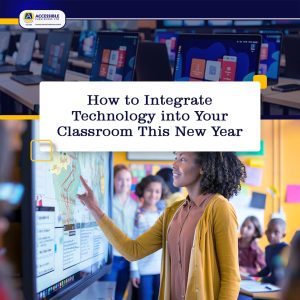In recent years, the use and adaptation of technology in every aspect of our daily lives has become increasingly common. Educators and education now transcend the traditional boundaries, teachers now bear the responsibilities of preparing students not only for academic success but also to navigate the intricacies of the digital era.
With the classrooms evolving into dynamic spaces where traditional chalkboards make way for interactive screens, the urgency to weave digital literacy into the educational fabric becomes ever more palpable. Digital literacy is no longer an educational agenda; it is the key to unlocking a realm of possibilities for students to engage with, comprehend, and contribute to the globalized, technology-driven society they live in.
This exciting journey of integrating digital literacy into the early school years begins a journey where education goes beyond the confines of textbook space and enters a realm where technology serves as a powerful ally in shaping informed, critical thinkers ready to navigate the complexities of our digital age. This thus begs the question, what then is digital Literacy?
What is Digital Literacy?
Digital literacy is the ability to use, understand, and navigate digital devices, technologies, and information effectively. It is the ability to use, access, evaluate, and communicate through digital platforms. Beyond the usage of technology, it includes the ability to sift through to determine the reliability of online information creating the capacity to engage with the digital world confidently and responsibly.
Fortunately, the load of teaching digital literacy skills in the classroom has been lightened as many Children nowadays seem to be born with basic functional skills. They are mostly surrounded by family and friends who use digital skills like searching the web, downloading, opening, and closing documents, using apps, recording, and editing videos, posting to social media, and so it becomes easier to imitate.
For students, digital literacy involves acquiring skills and knowledge to navigate, utilize, and critically engage with digital technologies. This involves; online safety, collaboration, problem solving, and information literacy.
For teachers, it encompasses the proficiency to effectively integrate technology into their teaching methods. This includes developing Competence to use platforms and devices, finding, evaluating, and integrating digital resources for education, critical thinking, and adaptability.
For teachers and students, digital literacy involves a combination of technical skills, critical thinking, ethical considerations, and adaptability to harness the full potential of digital technologies for learning and teaching.
Why is Digital Literacy Important?
Digital literacy has become so interwoven in our daily lives and so, we can barely think of staying a day without utilising them.
Think about it this way, if all the tech devices that you own and use each day stopped working for one week, how would you communicate, teach, listen to music or even do your laundry? Having the competencies to thrive with digital literacy is paramount.
Here are some of the importance of digital literacy.
- Effective learning:
Not all students learn and retain information in the same way. The use of technology allows students to work at their own pace, discover where their learning gaps are and easily reach out to teachers or classmates for assistance with specific problems.
- It saves time:
Online learning platforms can significantly enhance communication between teachers, students and parents. It’s easy to see past grades, current assignments, and key upcoming dates with the curriculum outline in an easy-to-use online portal.
- Motivates students to keep learning:
Digital literacy helps to motivate young learners in their learning due to their enjoyment and ease of use with various technological mediums.
- Access to materials:
The ability to use technological devices exposed students to multiple reading materials. It gives them easy access to educational materials needed for them to read and excel in their classes.
The importance of teaching digital literacy skills keeps going on and on. To enjoy these benefits and foster a more conducive classroom environment, empowering students with effective tools and strategies is key. Below are 5 ways to promote digital literacy skills in your classroom.
Ways to Promote Online Learning in Your Classroom
- Interactive Learning Environment:
Foster flexibility in learning by incorporating interactive technology. This not only empowers students to choose their learning methods but also enables teachers to provide direct feedback on their progress.
- Promote Online Etiquette:
Help students grasp proper online behaviour. Discuss the importance of avoiding inappropriate content and guide them on respectful communication to prevent issues like bullying or offensive behaviours.
- Encourage Student Blogs and Web Pages:
Allow students to create and maintain blogs, wikis, or web pages related to their learning. This provides a platform for them to express themselves and share insights with their peers.
- Utilize Educational Videos:
Integrate online videos into your lessons to add a multimedia dimension. This approach not only caters to visual learners but also positively impacts creativity, critical thinking, problem-solving, and memory, as suggested by various studies.
- Incorporate Educational Podcasts:
Leverage the vast array of educational podcasts available online. Find podcasts that align with your student’s needs, featuring interviews with book authors or providing supplemental materials. Download and play these podcasts in class to enhance the learning experience.
You can start by checking out our podcast platform Beyond the Pages Podcast.
Conclusion
In conclusion, using digital tools in class and at home broods students and helps to get them equipped with the necessary skills they need to thrive in this 21st century. So whether you’re a teacher, parent, or caregiver, your main job is to be the lead learner, to be able to teach and carry students along. By trying out the ideas mentioned earlier, you will be able to help them stay informed, efficient and safe in the online world.
Check out our literature catalogue to discover an array of titles that can help to motivate children to keep turning the pages. It’s time to explore and embark on an enriching literary journey.
Click this link to learn more about us here!







Judith Nwafor
26 Jan 2024Digital Literacy is the present and future of education. Thank you.
crie uma conta na binance
12 Nov 2024Your article helped me a lot, is there any more related content? Thanks!
binance
27 Dec 2024Your point of view caught my eye and was very interesting. Thanks. I have a question for you.
Buat Akun Binance
20 Jan 2025Your article helped me a lot, is there any more related content? Thanks!
Открыть счет на binance
11 Mar 2025Your article helped me a lot, is there any more related content? Thanks!
Регистрация в binance
11 Apr 2025I don’t think the title of your article matches the content lol. Just kidding, mainly because I had some doubts after reading the article.
binance
17 Apr 2025Thanks for sharing. I read many of your blog posts, cool, your blog is very good.